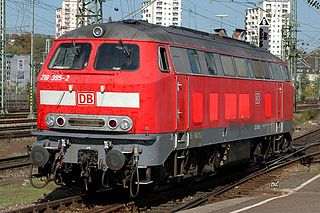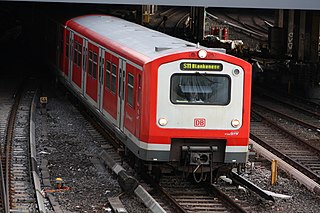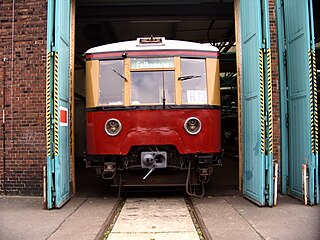
The Hamburg S-Bahn is a rapid transit railway system in the Hamburg Metropolitan Region. Together, the S-Bahn, the Hamburg U-Bahn, the AKN railway and the regional railway form the backbone of railway public transport in the city and the surrounding area. The network has operated since 1907 as a commuter rail system, under the direction of the state railway, and is a member of the Hamburger Verkehrsverbund. There are four lines, serving 68 stations, on 147 kilometres (91 mi) of route. On an average working day the S-Bahn transports about 590,000 passengers; in 2010 about 221 million people used the S-Bahn.

Alstom Traxx is a modular product platform of mainline diesel-electric and electric locomotives. It was produced originally by Bombardier Transportation and later Alstom, and was built in both freight and passenger variants. The first version was a dual-voltage AC locomotive built for German railways from the year 2000. Later types included DC versions, as well as quadruple-voltage machines, able to operate on most European electrification schemes: 1.5/3.0 kV DC and 15/25 kV AC. The family was expanded in 2006 to include diesel-powered versions. Elements common to all variants include steel bodyshells, two bogies with two powered axles each, three-phase asynchronous induction motors, cooling exhausts on the roof edges, and wheel disc brakes.

The Double-deck Coach is a bilevel passenger railcar currently manufactured by Alstom, which acquired Bombardier Transportation in 2021 used by various European railways and Israel Railways. The current generation of double-deck coaches can be run at speeds up to 200 km/h (125 mph). Depending on their configuration, each coach can seat 100 to 150 passengers.

The Class 422 is a series of four-car electric multiple units that are a derivative of the DBAG Class 423. The two inner cars in the set are designated as Class 432 vehicles.

The DBAG Class 612 is a two car, tilting, diesel multiple unit operated by the Deutsche Bahn for fast regional rail services on unelectrified lines.

DBAG Class 411 and Class 415 are German tilting electric multiple-unit high-speed trains in service with DB Fernverkehr, commonly known as ICE T.

The DBAG Class 605, commonly known as the ICE TD is a high-speed diesel multiple unit (DMU) train, formerly in service with Deutsche Bahn and DSB. It was retired from active passenger service in 2017 after years of operational issues with one trainset being kept and repurposed as a technology testbed.

The DR 130 family of locomotives comprises the DR Class 130, DR Class 131, DR Class 132 and DR Class 142, in USSR locomotive called TE109 and TE129.

The DB V 160 locomotive family comprises several classes of closely related 4-axle diesel-hydraulic locomotives built in the 1960s and 1970s for the Deutsche Bundesbahn which take the family name from the earliest built model: the 'DB Class V 160'.

The DRG Class ET 171 was a three-car electric multiple unit built for the S-Bahn Hamburg.

ÖBB Class 4011 are Austrian tilting high-speed electric multiple-unit trains, in service with Austrian Federal Railway (ÖBB). They were introduced in 2006, when ÖBB purchased three German DBAG Class 411 units, commonly known as ICE T, from the first batch of 32 originally ordered by Deutsche Bahn (DB). These units were renumbered as class 4011 in ÖBB's numbering scheme. Together with 12 DB Class 411, they form a pool for joint operation services between Germany and Austria.

The DB Class 472/473 is a three-car electric multiple unit train for the Hamburg S-Bahn. They were built to service the new lines through the city tunnel, to Harburg and to Neugraben. The livery was beige blue at first, but it was changed to verkehrsrot (traffic-red) in 1997. The Class 473 is the centre carriage of the Class 472, it differs from the predecessor centre carriages in its own electric motors and they have three door pairs instead of four.

The DBAG Class 474/874 is a three-car electric multiple unit train for the Hamburg S-Bahn. The class 474 were built to replace the nearly-60-year-old class 471 trains. Some units have a pantograph (474.3) to service the 2007 opened line to Stade on an overhead catenary track.

The Sieg Railway (German: Siegstrecke is a 100-kilometre long, electrified German main line railway between Cologne-Deutz via Porz, Troisdorf, Siegburg, Hennef, Au, Betzdorf to Siegen with a through service to Cologne Hauptbahnhof. Although most of it is two-track, two five-kilometre sections are only single track. Both ends of the line are in the state of North Rhine-Westphalia, but between Au and Niederschelden it runs through Rhineland-Palatinate. It is one of the oldest lines in Germany, opened between 1859 and 1862 by the Cologne-Minden Railway Company.

The DBAG Class 481/482 is an electric multiple unit train for the Berlin S-Bahn. The class 481 was designed to replace the aging rail cars after the German reunification in 1990. The first mock-up models were presented in 1993 with the first rollout on 22 January 1996.

The DR Class 270 was an electric multiple unit of the Berlin S-Bahn. It was designed for the Deutsche Reichsbahn and was intended to be the replacement for the ageing fleet of S-Bahn units in East Berlin. Test runs were started in 1987 and the first batch was delivered in 1990. After German reunification, Class 270 units were reclassified as DBAG Class 485. A second batch was cancelled in favour of a new design, the DBAG Class 481.

The BVG Class 480 is an electric multiple unit for the Berlin S-Bahn. It was originally meant to replace the aging S-Bahn rail cars in West Berlin, but after the reunification of the city, the remaining orders were cancelled and replaced by new orders for DBAG Class 481 cars in 1993.

The DBAG Class 611 is a two car, tilting, diesel multiple unit operated by Deutsche Bahn for fast regional rail services on unelectrified lines.

The 1941 Class ET 125, later adjusted series 276.0 (DR) or 477 (DBAG), was an electric railcar which traversed the DC-powered S-Bahn in Berlin during 1934/35. It was built in 1936 and 1938. The cars, which were popularly known as banker trains, were rebuilt after World War II and the series ET / EB 166 adapted. Among other things, they lost the more powerful 1949/50 traction motors. From the 1970s, they were included in the modernization program and in series 277 rebuilt, they were used on Berlin's S-Bahn network until 2003.
Intercity 2, abbreviated as IC2, refers to DB Intercity trains formed of double-deck rolling stock. Such trains were first introduced by Deutsche Bahn Fernverkehr in December 2015 to replace its aging IC coaches.



















